 Leading Blog | Posts by Month |
 Leading Blog | Posts by Month |
11.30.14

LeadershipNow 140: November 2014 Compilation
See more on
Posted by Michael McKinney at 10:06 AM
11.28.14

Accelerate (XLR8) IN order to reliably maintain an organization nothing beats a well-organized and well-developed hierarchy. But in order to grow, avoid collapse, and take advantage of the changes happening all around us, we need something more.
IN order to reliably maintain an organization nothing beats a well-organized and well-developed hierarchy. But in order to grow, avoid collapse, and take advantage of the changes happening all around us, we need something more.
John Kotter provides that extra something we need in Accelerate (XLR8). He writes that management-driven hierarchies are “still absolutely necessary to make organizations work.” So what he suggests is not an either/or but a both/and. It is a dual operating system. A second system that is organized as a network that works in cooperation with the existing hierarchy.
The second operating system does not take away from the existing organization but it adds to it, enhances it, feeds it. It is based on a few basic principles: • Many people driving important change, and from everywhere, not just the usual appointees. It recognizes the possible contribution made by anyone in the organization. “You need more eyes to see, more brains to think, and more legs to act in order to accelerate.” It gives more people the latitude to initiate—the foundation for developing leaders. • A “get-to” mindset, not a “have-to” one. Your existing people will step up but only if they “are given a choice and feel they truly have permission to step forward and act.” • Action that is head and heart-driven, not just head driven. Logic alone is not enough. People will want to help you if you can give them greater meaning and purpose to their efforts. • Much more leadership, not just management. Management is the guts of the engine, but “the name of the game is leadership, and not from one larger-than-life executive.” Both practices are crucial but management alone will “not guarantee success in a turbulent world.” • An inseparable partnership between the hierarchy and the network, not just the enhanced hierarchy. “The two systems, network, and hierarchy, work as one, with a constant flow of information and activity between them—an approach that succeeds in part because the people essentially volunteering to work in the network already have jobs within the hierarchy.” Kotter has found that “just 5 to 10% of the managerial and employee population in a hierarchy is all you will need to make the network function beautifully.” He describes eight accelerators for launching and sustaining this two-system model. 
Posted by Michael McKinney at 02:28 PM
11.26.14

Learn or Die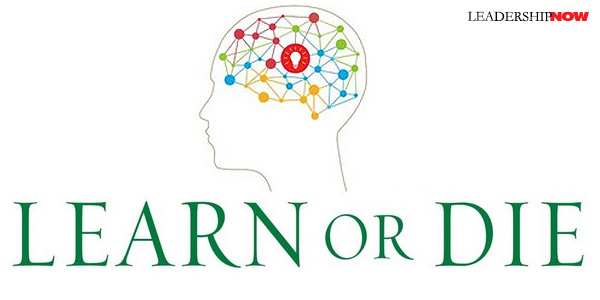
OUR ABILITY (and willingness) to learn impacts our personal and business growth, operational excellence, and our capacity to innovate. More than ever, it truly is learn or die. In Learn or Die, Ed Hess writes that learning is impacted by our “reflexive ways of thinking, the rigidity of our mental models, and the strength of our ego defense systems.” So to a large degree is means overcoming our humanness. We prefer to validate what we already know rather than looking at evidence to the contrary. By and large, that’s a function of our ego. “In many cases, learning comes from mistakes or failures or other people disagreeing with us, which that means in order to learn, we often have to admit that we are wrong.” The author admits that “To become a better learner, I had to quiet my ego.” As a result, he also became a better thinker and leader. Negative thinking is toxic to learning. “In order to maximize our learning we have to be sensitive to and manage our emotions.” As a leader, you need to be concerned about the environment of the people you lead. “The litmus test of a learning organization is being receptive to information that goes against the established way and a tolerance for failure and mistakes.” To accomplish this not only should the environment be positive, but people need to be treated with respect, dignity, and trust, mistakes should not be characterized as “personal failures but as the result of bad learning systems or too little effort,” people should also believe that they have some control over their actions, have a sense of self-efficacy and contribution. Hess writes that “The U.S. Army Special Forces believes that adaptability—learning—is predicated on self-efficacy, resiliency, open-mindedness, mastery achievement motivation, and tolerance for ambiguity and uncertainty.” Too often we sabotage our own learning by our need to be right. We need to be able to admit when we are wrong and quite frankly accept the “magnitude of our ignorance.” “Real learning, in most cases, requires us to change what we believe, and humble inquiry [open-mindedness with no predetermined or hidden agenda], helps us do that.” Because we have difficulty seeing ourselves and examining our own assumptions, “learning is a team sport.” If we want to learn, we “must engage in effective learning conversations.” Learning conversations are conversations where we feel safe in disclosing ourselves to others. They bring about a deliberate, nonjudgmental, non-defensive open-minded exchange. We learn from each other.
The culture at Bridgewater may seem extreme to some but there is no doubt that they are serious about growth and learning. As Ray sees it, achieving one’s goals is more likely to occur if one strives to be an independent thinker by learning. That, in turn, requires one to be honest about one’s strengths and weaknesses and to deal directly with one’s weaknesses by accepting them, seeking and being open to feedback and creating workarounds that mitigate one’s weaknesses. At Bridgewater, everyone knows everyone else’s strengths and weaknesses. It’s part of their company-wide feedback loop. It’s based on truth which Ray believes “is the essential foundation for producing good outcomes.” “Searching for the truth and confronting one’s personal weaknesses in a radically transparent environment builds personal relationships.” At Bridgewater they are just as concerned about how one arrives at an answer as they do the answer itself. They encourage people to be independent thinkers. A former Navy SEAL came to work at Bridgewater because he said the two cultures overlapped. “He said both organizations focus on learning, adaptation, recruiting high caliber people, and teaching them to be better thinkers and to relentlessly pursue constant improvement.” Bridgewater has created a series of tools for use in evaluating employees and for employees to manage their personal growth” the Dot Collector and Dot Connector, Issues Log and Issue Log Diagnosis Card, Pain Button and Baseball Card. With the Dot Collector allows anyone to give any other employee performance feedback. The Dot Connector is a database of feedback every employee has received from anyone. The data is grouped according to a list of seventy-seven attributes and then summarized to give each employee a picture of his or her feedback by strengths and weaknesses and by attributes. The Pain Button app is based on Ray’s formula: Pain + Reflection = Progress. “The purpose of the pain app is for one to write down and reflect on the ‘pains’ one is experiencing in order to understand what’s causing them and to deal with those causes effectively.” Ray himself is included in the process and is subject to evaluation by anyone in the company. Frankly, I have never read about an organization with such radical transparency. Hess says that in all of his research of over 100 high-performance companies over the past ten years, Bridgewater is the only business organization he has found that “has squarely faced our ‘humanness.’” Learn or Die is a book everyone who is serious about learning and growth—personally or organizationally—should read. If you thought you were serious about it, Learn or Die will take you to a whole new level with tools, case studies, and insights that will challenge your commitment to learning.

Posted by Michael McKinney at 11:28 AM
11.25.14

The Age of Enlightenment and You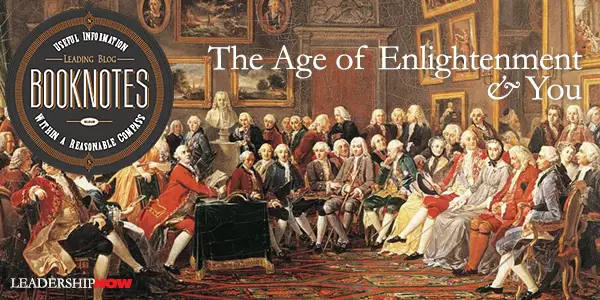
☙ Enlightenment remains the most powerful tool for challenging authority and liberating the human mind, an inspiration to leaders and followers worldwide, a method for effective change, and a framework of values by which that change can be measured. ☙ No single idea of the Enlightenment was so laden and sweeping as this. If people could transform their minds, they could change their lives, and together with others they could change their communities and beyond. ☙ Thomas Jefferson’s Declaration of Independence was less a guide to committed leadership than a resounding statement of Enlightenment ideals that had served its purpose of uniting Americans for war. ☙ Thomas Paine’s Common Sense expressed an aspiration that lay at the heart of the Enlightenment, the dream of revolutionaries everywhere, that the people “have in our power to begin the world over again.” ☙ No one had a greater role in fashioning the American experiment, basing the government on Enlightenment principle and then testing them in action than James Madison. ☙ Pursuing private interests, untethered to the thick social structure of old aristocracies, lacking deep familial roots, free of tradition and inherited beliefs, constantly on the move, democratic man, in Tocqueville’s portrait was profoundly alone. Lacking them, people would be crushed under the hypertrophy of selfhood; they would suffer the full consequences of the liberal society that made the isolated self the measure of all things personal and political and the market economy that made money the measure of all things economic and social. ☙ For Enlightenment pioneers, it meant embracing mankind as the measure of all things—not authority, not custom, not faith, but individual perception and reason were the foundation of truth. 
Posted by Michael McKinney at 08:58 AM
11.24.14

These Are Hard Times for Leaders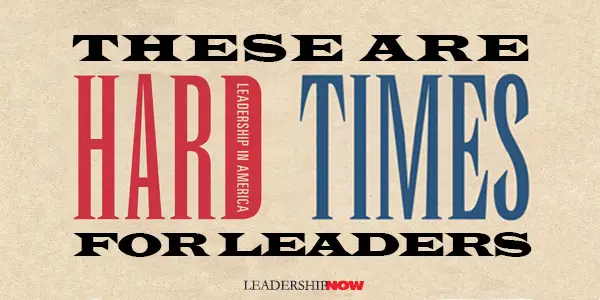 BARBARA KELLERMAN has written about leaders (good and bad) and followers, but in Hard Times she turns her attention to the often-overlooked context in which we lead. Leaders, followers, and context, form a system of leadership.
BARBARA KELLERMAN has written about leaders (good and bad) and followers, but in Hard Times she turns her attention to the often-overlooked context in which we lead. Leaders, followers, and context, form a system of leadership.
“More than ever,” writes Kellerman, “it is better—better in practice and better in theory—to focus less on the leader and more on the leadership system.” It is difficult to navigate or change systems without understanding the underlying context they exist in. We diminish our capacity to lead when we don’t consider all aspects of leadership. Hard Times is about context. It’s not about looking in but looking out. Everywhere leaders are finding it difficult to lead without using or threatening to use force because everywhere followers are making their lives difficult—and because everywhere context is both a cause and an effect of this power dynamic. So this book is about what leaders need to know to develop contextual expertise. Her extensive examination considers twenty-four different ways the context in which we lead shapes leadership now—in the United States—in the second decade of the twenty-first century. However, much of what she discusses is global because it is human. Tackling America’s historical background, she writes, “When the history of a country leaves a legacy that renders its citizens virtually allergic to authority, leadership is more difficult.” The capacity to persuade is more important than the capacity to control.
Other contextual issues like money as influence, the anxiety of innovation, the competitive need to be first, class distinctions, cultural pressures, divisiveness, special interest groups, environmental issues, and risk management, have all intensified. These all serve to undermine leadership confidence and put us off-balance. Risk management is not something that we generally like to spend our time thinking about. And unfortunately, some risk management platitudes only serve to put us asleep—only to wake up when a real risk comes along and we are ill-prepared to deal with it. We need to develop “risk management based not on what we know, or think we know, but on what we do not know.” Leaders and followers have changed in profound ways too. In general, says Kellerman, all this adds up to the fact that leaders are getting weaker. Leaders may not have less influence but they do have less power. Titles mean less and “status means less, which means that their ability to lead has lessened as well.”As Kellerman, Moisés Naím and others have argued, power is “undergoing a historic and world-changing transformation. Big players are increasingly being challenged by newer and smaller ones, and those who have power are more constrained in the way they can use it.” While I think this has always been and will continue to be an underlying truth on a micro level, we may very well see a backlash on this trend at the macro level. Time will tell. The most obvious reason leaders have been enfeebled are first, changes in culture that entitled and embolden subordinates to demean and diminish their putative superiors, and second, changes in technology that enable ordinary people to obtain information, engage in self-expression, and make interpersonal connections in ways and to degrees that historically are unprecedented. Increasingly, unable to rely on power and authority, on a more general level leaders are having to become what true leadership is about: influence. Exercising influence is what leaders should have been doing (and should have been trained to do) instead of relying on position and power because they could get away with it. Leaders “are more dependent than they ever were on their capacity to exercise influence.” As leaders we need to keep focused not just on the leader and the followers but on the context in which they interact. “Leading has become a high-wire act that only the most skilled are able to perform successfully over a protracted period of time.”
Kellerman’s insight at the end of the book is worth repeating because it says so much: “Leadership is not a profession.” Amen. 
Posted by Michael McKinney at 09:15 AM
11.19.14

The Ten Golden Rules of Leadership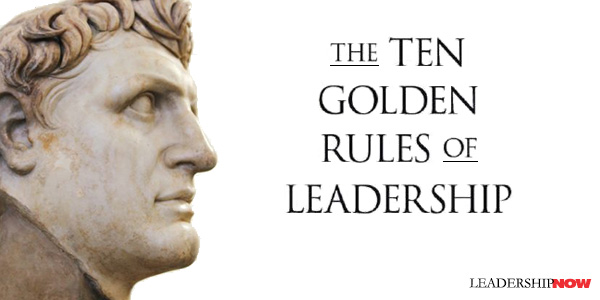
MICHAEL SOUPIOS and Panos Mourdoukoutas have reviewed the writings of the Classical philosophers and selected ten ideas that will positively impact our leadership effectiveness in The Ten Golden Rules of Leadership. Not surprisingly, the philosophies of classic figures remain relevant in today's workplace. Early on, the authors suggest that the raw material of leadership is not latent in just about everyone and rightly discredit the idea that it “just takes a nudge to trigger its unfolding.” Further, they say that the “special qualities of genuine leadership are remarkably complex and rare.” It is true that good leaders are not as common as they need to be and that we do confuse administration with actual leadership as they suggest, but the potential is there in each one of us. The problem is that it remains latent in many of us. We choose not to do the work necessary and instead assume reading “Leadership Lessons I Learned from My Cat” is enough to unlock our potential. The authors do expose the real culprit at the end of the book: “Achieving the rank of genuine leader is a daunting task that most will find prohibitively challenging.” In short, “leadership requires a special form of courage: the courage to fashion a code of conduct governed by principled conviction.” Genuine leadership is not complex, but it is difficult because it requires that we do the inner work on a continual basis. And that is a lot to commit to. It’s lifelong. And what we want to do is to check it off and mark it as good enough. Sustainable leadership requires a radical life-long commitment to rule one of leadership: Know Thyself. Rule 1: “Know Thyself.” –Thales
Rule 2: “Office Shows the Person.” –Pittacus
Rule 3: “Nurture Community at the Workplace.” –Plato
Rule 4: “Do Not Waste Energy on Things You Cannot Change.” –Aristophanes
Rule 5: “Always Embrace the Truth.” –Antisthenes
Rule 6: “Let Competition Reveal Talent.” –Hesiod
Rule 7: “Live Life by a Higher Code.” –Aristotle
Rule 8: “Always Evaluate Information with a Critical Eye.” –The Skeptics
Rule 9: “Never Underestimate the Power of Personal Integrity.” –Sophocles
Rule 10: “Character Is Destiny.” –Heraclitus

Posted by Michael McKinney at 04:24 PM
11.17.14

Do You Have Moxie?
LEADERS WITH MOXIE are leaders that have what it takes to lead others in tough circumstances. They are tough on the outside but soft on the inside. When knocked down they know how to get back up and they can bring others with them because they are likeable. John Baldoni, author of MOXIE, says that “Leadership post-crash is not really any different from leadership pre-crash, except for one thing: resilience.” Leaders with moxie have four key attributes: Fire. They have a passion for what they do and have a need to make a positive difference in the lives of others. Drive. They have ambition and want others to share in it. Resilience. They have known defeat and it doesn’t scare them. They know how to pick themselves up after a fall. Street Smarts. They know how the world works and what makes people tick. Baldoni breaks moxie down into five characteristics that you can practice and develop to be a leader that demonstrates moxie. Each characteristic is brought to life through the examples of leaders who have demonstrated it in their own life and leadership. The first is Mindfulness. “A mindful leader knows the situation as well as his capabilities and those of the people around him.” aware if his situation but at the same time focused on what could be done to improve it. Mindfulness “prepares leaders to focus on the present as well as prepare for the future”— to be aware of your situation but at the same time focused on what could be done to improve it. 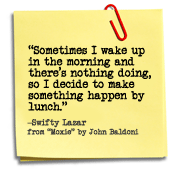 Second is Opportunity. “An opportunistic leader looks for ways to make things better. She is motivated by a desire to make a positive difference.” That means a willingness to see beyond the immediate problem and see the possibilities over the horizon. Second is Opportunity. “An opportunistic leader looks for ways to make things better. She is motivated by a desire to make a positive difference.” That means a willingness to see beyond the immediate problem and see the possibilities over the horizon.
Third is X-Factor. “A leader with the X-Factor has what we call ‘the right stuff of leadership.’ She radiates character and uses her ambition to focus on the right goals. She has the persevering spirit that radiates resolve. Leaders with the X-Factor are humble, and their humility attracts others to them.” The X-Factor is those things that allow you to do what you do well: character, beliefs and talent. These can all be examined and improved. In addition, look for opportunities to improve through more training and consider taking on responsibilities that stretch you. Fourth is Innovation. “An innovative leader knows that life is not lived in a linear fashion. Sometimes you need to take risks. That means thinking differently, doing differently, and rewarding others who do the same.” Leaders with moxie aren’t content with the status quo. They are tuned to the future. A “forward-themed outlook is not merely one of observation, it is one of application….That gives rise to innovation.” Fifth is Engagement. “Persons with moxie seek to engage with the wider community around them. They are focused on making a positive difference in their teams and in their organizations.” Leaders must work through others. “Engagement is an essential part of extending the leadership self in order to make a positive difference.” All of us can demonstrate moxie when the going gets tough. Preparing and developing yourself now sets you up to make better decisions when you do get knocked down. Moxie is full of great stories and examples making it immediately relatable and practical. It is structured so that you can thoughtfully and tactically look at each of these areas to see where you can better prepare yourself. Baldoni also provides an appendix that works as a handbook to guide you in this. Questions, examples, additional thoughts and action steps help you access where you are at and what you might need to do next. Moxie is not just about your work life, it also impacts every other aspect of your life and positively influences the lives of those you touch. Of Related Interest: 
Posted by Michael McKinney at 06:50 PM
11.07.14

How to Pull Yourself Back from the Brink of Your Caffeine-Driven, Smart Phone-Addicted Life On a summer Sunday night four years ago, I found myself standing in front of a roomful of about 80 corporate managers who probably didn’t want to be there. They had just finished the first week of a high-profile leadership development program in one of the world’s largest companies and week two was scheduled to start at 7:30 am the next morning. They were polite but understandably restless. I was there as a guest speaker brought in to share some of what I’d learned from working with several hundred other leaders in their company. Since high-achieving people usually like to compare themselves to their peers, I asked if they’d like to see the summary results of hundreds of leadership behavior self-assessments completed by those other leaders. Of course they said yes. Starting with the highest assessed behaviors, everyone could quickly identify with commitment to behaviors like making timely decisions, being clear about priorities and accepting accountability for results. Then we took a look at the lowest assessed behaviors like pacing myself, taking regular time to step back and giving others my full presence and attention. There were nods and murmurs of recognition. I summed it up for the group with the headline, “Leaders in your company are so busy doing stuff that they probably don’t see what needs to be done. Then the room erupted. Not in anger but in vociferous agreement. “Yeah, that’s exactly it!” one person exclaimed. “Yeah, another agreed, they expect us to be corporate warriors, answer e-mails at 2:00 in the morning and get by on four hours of sleep a night.” Several people at once said, “We can’t keep this up.” The conversation I led that evening was the beginning of work and a thought process that led to my new book, Overworked and Overwhelmed: The Mindfulness Alternative. One of the things I’ve noticed in my work as an executive coach and speaker over the past four or five years is that most of the executives, managers and professionals I work with are trying to work harder every year. The demands of a “do more with less” culture and a 24/7, smart phone enabled operating environment have left too many people teetering on the brink of a caffeine-addicted, sleep-deprived, stressed-out existence. The impact of all of that on short-term productivity and happiness and long-term health and well being is devastating. Because of all they’re trying to do and pay attention to many of the leaders and professionals I work with are in a chronic state of fight or flight. Their stress hormones and blood pressure are too high and their immune and digestive systems don’t operate at healthy levels. In the short run, all of that leads to anxiety, insomnia, poor decision making, lack of focus and generally poor health. In the long run, it leads to broken relationships, premature aging and early death. The point I’m trying to make in Overworked and Overwhelmed is it doesn’t have to be that way. There are simple, relatively easy steps you can take to pull your life from the brink. That’s where the mindfulness alternative comes in. Over the past few years, mindfulness has gotten more and more attention in the mainstream media – it's even made the cover of Time magazine. The picture that a lot of people get in their minds when they hear the word mindfulness is of blissed out people sitting cross legged while they meditate and chant. That’s one way to do it, but it’s not something that most stressed out professionals are going to do. What I’m presenting in my book is what I’ve learned about how the basics of mindfulness can be used and applied by just about anyone who needs to get out of chronic fight or flight. We all know what fight or flight is – it’s supposed to be the emergency response system controlled by your body’s sympathetic nervous system. It’s a big problem when the fight or flight response gets stuck in the on position and becomes chronic. That’s where another system that all of us have but few of us have heard of comes into play. It’s called your rest and digest response and is controlled by your body’s parasympathetic nervous system. You can think of it as fight or flight being the gas pedal and rest and digest as the brakes. We need to exercise both throughout the day to be healthy, happy and effective. Fortunately, there are simple, easy to do routines that we can learn from the practice of mindfulness that can help even the most overworked and overwhelmed people activate their rest and digest response. I summarize a lot of those routines in my book and offer a simple one-page framework called the Life GPS® that helps make it easy to follow through on the routines that help you show up at your best. The Life GPS® asks for your answers to three questions:
It’s never too late to pull yourself back from the brink and reclaim your life. Now is a great time to get started. My goal with Overworked and Overwhelmed is to help you do that. 
Posted by Michael McKinney at 01:37 PM
11.01.14

First Look: Leadership Books for November 2014Here's a look at some of the best leadership books to be released in November.




For bulk orders call 1-800-423-8273  Build your leadership library with these specials on over 100 titles. All titles are at least 40% off the list price and are available only in limited quantities. “I find television very educating. Every time somebody turns on the set, I go into the other room and read a book.” — Groucho Marx
Posted by Michael McKinney at 08:33 AM
|
BUILD YOUR KNOWLEDGE


How to Do Your Start-Up Right STRAIGHT TALK FOR START-UPS 
Grow Your Leadership Skills NEW AND UPCOMING LEADERSHIP BOOKS 
Leadership Minute BITE-SIZE CONCEPTS YOU CAN CHEW ON 
Classic Leadership Books BOOKS TO READ BEFORE YOU LEAD |
|